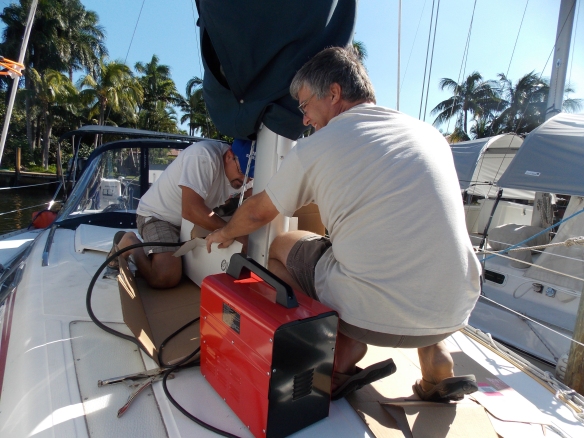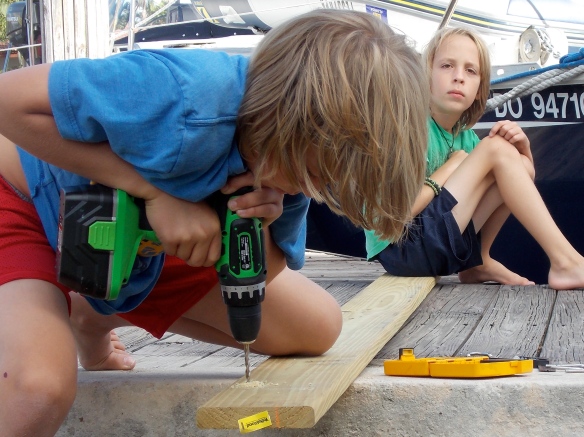11/8/12
Our friend Lee came out to our boat yesterday and today. We have been replacing a homemade navpod with the real deal. Monday when Jason from Nance and Underwood came out to work on our reefing system we discovered one of the supports for the running rigging was missing where it attached to the base of the mast. It had broken at some point in the past. Lee welded a new support back in place returning the brace to its former strength.
After two days we completed the work on the new navpod. We relocated the auto pilot to the port side of the cockpit. I had to have a new bar fabricated to hold the navpod. The work was done by Stuart at JTL Marine Engineering. He did a great job bending the new bar for us, it was a prefect fit. Lee was a big help working on the navpod and moving the autopilot to say the least. It was like the cavalry had shown up when he arrived with a welder and tools in hand.
11/12
This morning Cole caught a Checkered Puffer Fish at the dock. He was using a piece of shrimp on a jig head. The puffer had 4 little bony teeth, 2 on the top and 2 on the bottom and he puffed up when we took the hook out to let him go. They are very comical looking fish.
Yesterday, Christine finished whipping the anchor line and we started provisioning for the trip. We bought about $300 worth of canned goods at Wal-Mart. The boys wrote the names of the contents on all the cans just in case we lose the labels in the bilge. We completed the task of clamping 2 boards between the stations where we will attach extra fuel and water jugs.
I finished the work on our engine hoist yesterday. Essentially, I mounted an L-shaped bar upside down and next to the outboard on the stern. The bar rests on a flange that allows it to rotate the outboard over the side of the boat and be lowered to the dinghy using an old mainsheet pulley system that we brought with us from Idaho. A couple of U bolts keep the bar firmly against the stern rail but not so tight that you can’t rotate the bar. At $85.00 it was a low-cost, low-tech solution to moving our outboard to and from the dinghy.
Last week we replaced our anchor chain, which was only 27 feet long with 70 feet of new chain. Christine used her braiding skills to splice the rope rode to the chain. The combination of 2 boat lengths of chain and our new Rocna anchor will help us rest easier when we are at anchor.
The door of the anchor locker was another project, which took some time to find a solution to. When we bought the boat, it had a windlass mounted to the locker door but the door wasn’t mounted to the boat. My solution, was to cut the door in half, hinge one half for access to the locker, then permanently mount the other half with the windlass to the boat. Since the windlass would be putting a great deal of strain on the door, its attachment needed to be robust. I used 2 stainless steel bars through bolted to the deck and a piece of aluminum angle iron to anchor the door at 3 points on the deck and to keep the door from flexing when you walk on it.
In all we are pretty close to being done with all the work we need to do in order to go on our cruise. The projects have taken longer than I expected them to take. It’s hard to believe that we have been working on the boat for almost 2 months now. The upside is we have addressed all the areas of greatest concern and we have learned a great deal about our boat in the process.
Fair winds,
Mark




















